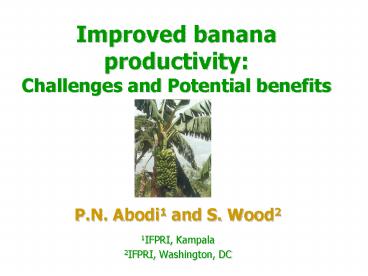Improved banana productivity: Challenges and Potential benefits - PowerPoint PPT Presentation
1 / 24
Title:
Improved banana productivity: Challenges and Potential benefits
Description:
Banana weevil. Up to 100% for affected fields (Okaasai et al, 2004) Bacterial wilt ... Banana Weevil. poor crop establishment. reduced nutrient uptake ... – PowerPoint PPT presentation
Number of Views:344
Avg rating:3.0/5.0
Title: Improved banana productivity: Challenges and Potential benefits
1
Improved banana productivity Challenges and
Potential benefits
- P.N. Abodi1 and S. Wood2
- 1IFPRI, Kampala
- 2IFPRI, Washington, DC
2
Overview
- Some banana facts
- Production and market trends
- Cost of production and profitability
- Constraints
- Potential Economic Benefits
- Summary
3
Some Banana Facts
- Banana is the dominant food staple in Uganda
- 3 main banana use types cooking (matooke),
brewing (mbidde), and sweet/dessert (sukali ndizi
- the apple banana, bugoya - Gros michel, and
Cavendish) - We focus our attention on matooke.
- In 1999/2000, 5.5M tons of matooke produced on
about 450,000 ha (1.75M plots, av. size 0.26
ha, UNHS 1999/2000). In the 1995/96 HH
monitoring survey, production estimated at 7.9M
tons. - 61 produced in Western region, 30 in Central.
Matooke is hardly grown in the Northern region.
4
Some Banana Facts - contd
- Banana-coffee systems found to be dominant
livelihood strategies in C and W Uganda (Pender
et al 2004) - Large westward movement of production from C to W
since 1970s (Sserenkuma 2003), increasing
transport costs to main markets - With increased commercialisation, increase in
export of nutrients from the farms - Of the wholesale price of 3750 sh per bunch,
farmers receive 750 sh. Local traders make the
largest net margin 650 sh (Foodnet, 2002)
5
Banana production areas and intensity of
production in East Africa
(Source INIBAP Annual Report, 2002)
6
Matooke Production in Uganda
Source Spilsbury, March 2003. FEWSNET
7
Production trends
- Harvested Area Uganda 1961-2003
Source FAO 2004
8
Production trends
Production and Yield 1961-2003
9
Domestic Wholesale Prices Matooke (Nominal
Ug.Sh/Kg. 5 week moving av)
Source Compiled from FOODNET 2004
10
Exports 1997-2001
Source FOODNET 2002
11
Matooke Indicative Cost of Production (per ha
per yr)
12
Matooke Indicative Cost Of Production contd
(Source NAADS Profitability Report, 2003)
13
Constraints
- Pests Diseases
- Declining soil fertility
- Narrow genetic base
- Postharvest
- Socio-economic
14
Constraints
Source Nankinga 2002
15
Banana Weevil
poor crop establishment reduced nutrient
uptake weakened plant stability mat die out plant
loss (snapping and toppling) reduced bunch size
reduced plantation life
Source Nankinga 2002
16
Bacterial Wilt
17
NARO Banana Monitoring Sites
18
Cause of crop decline Farmers Perspective
Source Nankinga 2002
19
Priority Research IssuesResearcher perspective
Other lower priorities .. ..
20
Appropriate Technology Responses
- There is general agreement from literature
reviews and scientist elicitation that improved
cultural practices and the development of
resistant cultivars (by both conventional and
biotech) are essential for the control of pests
and diseases.
21
DREAM scenario for assessing the potential
economic benefit of technical change
- Scenario has two components
- Switching from a 20 best practices and 80
traditional in 2004 - to 20 traditional and 80 best practices by
2015 (NAADS?) - (b) An additional 1.5 percent per year from new
technologies/best practices that will become
available between 2005 and 2015 (NARO)
22
Distribution of Matooke Productivity Enhancement
Benefits
Distribution of Gross Total Benefits by Region
and Household Consumption Quintile (000 US)
Gross Benefits (000 US)
Lowest 20
23
Concluding Remarks
- High degree of speculation and uncertainty about
basic production statistics - Pests, diseases and soil fertility continue to
present major challenges to productivity - Main focus of production-focused strategies are
on pest and disease mitigation and soil fertility
management - Attention also being paid to improving the
efficiency of marketing channels - Growing interest in the development of
value-adding products to stimulate demand and
absorb excess supply - Appears to be considerable inequity in the
distribution of benefits of growth in the sector
24
Acknowledgement
- Collaborators NARO, INIBAP, UBOS, IITA, MUK
- Thank you ladies and gentlemen































